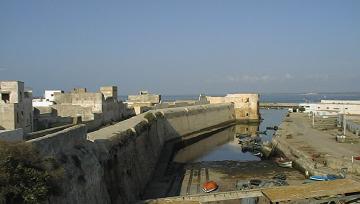
El Jadida
September 5th - September 7th, 1999

In our attempt to visit little town off the beaten track, we trekked down to El Jadida, a small beach town just under two hours south of Casablanca. Founded by the Portuguese in 1513, "ne Mazagan" as it was called was their first and last possession in Morocco. Taken back in 1769, it was converted into a Jewish mellah -- the segregated area where Jews, mostly merchants, were supposed to live. Now completely muslim, we hoped that the combination of culture and nice beaches would be a finish to our time in Morocco.
The walls of the old Portuguese city were restored in the 19th century and are open to the public. They offer a nice view on the ocean, and a few rusting cannons of various vintages, the oldest being the severely rusted 17th century Portuguese. Little else is restored from that time, and off limits to the tourists. An example of this is the old synagogue (below right); while standing and in good shape on the outside, it's empty and locked up.
|
|
 On the synagogue was an interesting combination of symbols we hadn't
seen before. It's the star of David underneath the muslim crescent. We surmise
it symbolizes the appreciation of the Jewish population of the time at being
accepted by a Islamic country after fleeing persecution at the hands of
the Christian Spanish, and of their desire to integrate into Moroccan life.
Integration was never complete, as Jews here always lived under a different
set of laws than muslims (one was they were not allowed to wear shoes!).
No Jews live here now, as they all left for Israel after its founding.
On the synagogue was an interesting combination of symbols we hadn't
seen before. It's the star of David underneath the muslim crescent. We surmise
it symbolizes the appreciation of the Jewish population of the time at being
accepted by a Islamic country after fleeing persecution at the hands of
the Christian Spanish, and of their desire to integrate into Moroccan life.
Integration was never complete, as Jews here always lived under a different
set of laws than muslims (one was they were not allowed to wear shoes!).
No Jews live here now, as they all left for Israel after its founding.
Inside the old fortress lies an ancient structure that escaped the destruction of the fleeing Portuguese. The Portuguese Cistern is severely misnamed, as it was actually built by the Romans and used by the Portuguese as a way of storing water to withstand sieges. If it looks familiar, it's because the riot scene from the movie Othello by Orson Welles was filmed here.
|
|
We have to admit that we were disappointed by the beaches at El Jadida. Even dirtier than Essaouira's, they didn't seem that pleasant for swimming despite the vastly reduced September crowds. However, they were nice for long walks, offering interesting volcanic rock formations, tidal pools filled with crabs, fish and anemones, and pretty sunsets.
|
|

Just as wrecked cars down embankments are stripped and left in place, shipwrecks are treated in a similar manner. Here's one half of a wrecked ship resting against the city's breakwater; the other half is stranded on the sand about two miles to the south.

The last day we were in El Jadida we noticed a very odd phenomena that our noses couldn't help but notice -- it was Dead Fish Day. Perhaps it was coincidence, but there were dead fish everywhere. Dumped in piles on the sidewalk and behind buildings, littered among the bushes, and strapped to bicycles, they seemed to be in every corner. We didn't notice a fish market that day, so we're at a loss to explain it.
While we were disappointed with El Jadida, we did find that there are some better beaches farther down the coast. The big tourist trap beach is Agadir, offering a quality, Cadiz-style beach experience. Less touristy and more real are Sidi-Moussa (40 km south of El Jadida), Oualidia (70 km south) and Sidi Ifni (250 km south). This is hearsay on our part, so please take it with a grain of salt. If our experiences with Moroccan beaches tells us anything, it's that the best beaches are the cleanest ones, and if there are people around then there's shit around as well -- thus the best beaches are the ones away from all the cities. That does make them hard to reach by bus, though, and since we've only a few days left we decided to enjoy El Jadida for its nice restaurants and pretty walks.
Health Note
We finished our anti-biotics regimen in El Jadida and are pleased to report that we're finally back to normal. It's hard to tell what exactly we had as we started both the giardiasis medicine and the anti-biotics at the same time, but we suspect from the way our bodies responded that we were infected with both. A little more rest will be necessary before we're back to 100%, but to have our bodies functioning normally again is quite a joy.